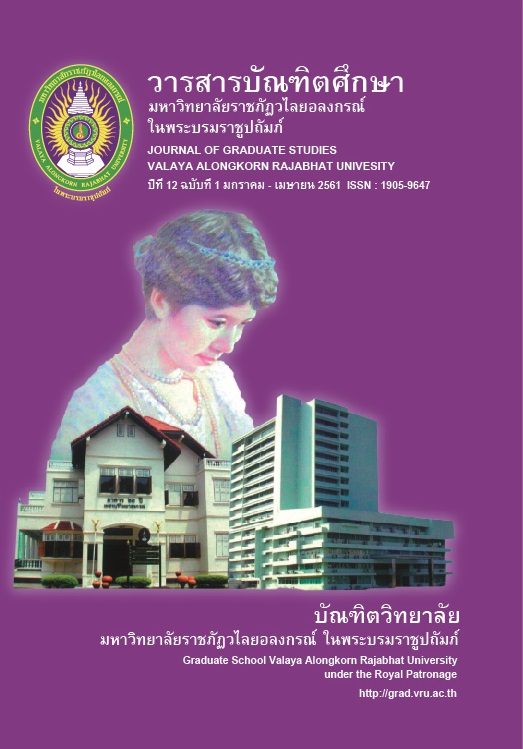ผลของการฟังของครูในการสอนคณิตศาสตร์ด้วยวิธีการแบบเปิดที่มีต่อบทบาทการสอนของครู
Main Article Content
บทคัดย่อ
การศึกษาครั้งนี้มีวัตถุประสงค์เพื่อวิเคราะห์ผลของการฟังของครูในการสอนคณิตศาสตร์ด้วยวิธีการแบบเปิดที่มีต่อบทบาทการสอนของครู กลุ่มเป้าหมายเป็นครูสอนคณิตศาสตร์ ระดับชั้นประถมศึกษาปีที่ 1 จำนวน 1 คน และนักเรียน จำนวน 12 คน ชั้นเรียนที่ใช้เป็นชั้นเรียนที่อยู่ภายใต้บริบทการศึกษาชั้นเรียนและวิธีการแบบเปิดมาอย่างต่อเนื่อง ดำเนินการเก็บข้อมูลโดยใช้วิธีการสังเกตและบันทึกพฤติกรรมการฟังของครู และบทบาทการสอนของครู การวิเคราะห์ข้อมูลใช้การพรรณนาวิเคราะห์ ผลการศึกษาพบว่า การฟังของครูในระหว่างการสอนคณิตศาสตร์ด้วยวิธีการแบบเปิดมีผลต่อบทบาทการสอนของครู ดังนี้ (1) ครูฟังเพื่อกระตุ้นให้นักเรียนพิจารณาปัญหาจากภาพ และเล่าเรื่องของสถานการณ์ปัญหา (2) ครูฟังเพื่อรวบรวมแนวคิดทางคณิตศาสตร์ของนักเรียน (3) ครูฟังเพื่อการอธิบายและเปรียบเทียบแนวคิดของนักเรียนที่เกิดขึ้น (4) ครูฟังเพื่อสรุปวิธีการเรียนจากแนวคิดของนักเรียน
The objective of this study was to analyze the effects of teachers’ listening in teaching mathematics using open approach on her teaching roles. The target group of this research study consisted of one mathematics teacher and 12 first graders. The classroom used in this research study has continually been under the lesson study and open approach context. In this study, data were collected from observation and recording of the teacher’s listening behavior and teaching roles. Descriptive analysis was employed in data analysis. Research findings indicated that the teacher’s listening during mathematics teaching using an open approach caused the teacher to play the teaching roles as follows: (1) The teacher listened to encourage students to consider problems from the pictures and storytelling of the problem situations, (2) The teacher listened to collect the students’ mathematical ideas, (3) The teacher listened to explain and compare the students’ ideas expressed, and (4) The teacher listened to summarize learning methods from the students’ ideas.
Article Details
บทความทุกเรื่องได้รับการตรวจความถูกต้องทางวิชาการโดยผู้ทรงคุณวุฒิ ทรรศนะและข้อคิดเห็นในบทความวารสารบัณฑิตศึกษา มหาวิทยาลัยราชภัฏวไลยอลงกรณ์ ในพระบรมราชูปถัมภ์ มิใช่เป็นทรรศนะและความคิดของผู้จัดทำจึงมิใช่ความรับผิดชอบของบัณฑิตวิทยาลัย มหาวิทยาลัยราชภัฏวไลยอลงกรณ์ ในพระบรมราชูปถัมภ์ กองบรรณาธิการไม่สงวนสิทธิ์การคัดลอก แต่ให้อ้างอิงแหล่งที่มา
เอกสารอ้างอิง
ไมตรี อินทร์ประสิทธิ์ และคณะ. (2557). คำอธิบายการใช้หนังสือเรียนคณิตศาสตร์ ชั้นประถมศึกษาปีที่ 1. ขอนแก่น: มหาวิทยาลัยขอนแก่น.
ไมตรี อินทร์ประสิทธิ์และคณะ. (2557). กระบวนการแก้ปัญหาในคณิตศาสตร์ระดับโรงเรียน. ขอนแก่น: มหาวิทยาลัยขอนแก่น.
Arcavi, A., & Isoda, M. (2007). Learning to listen: From historical sources to classroom practice. Educational Studies in Mathematics, pp.111-129.
Ball, D. L., & Cohen, D. K. (1999). Developing practice, developing practitioners Toward a practice-based theory of professional education. In L. Darling-Hammond & G. Sykes (Eds.), Teaching as the learning profession. Handbook of policy and practice (pp. 3–32). San Francisco, CA: Jossey-Bass.
Boles, K., Troen, V., & Kamii, M. (1997). From carriers of culture to agents ofchange: Teacher-initiated professional development in the learning/teaching collaborative inquiry seminars. Paper presented at the annual meeting of the American Educational Research Association, Chicago, IL.
Carpenter, T., & Fennema, E. (1992). Cognitively guided instruction: Building on the knowledge of students and teachers. In W. Secada (Ed.), Researching educational reform: The case of school mathematics in the United States (pp. 457-470). A special issue of International Journal of Educational Research.
Cobb, P., Jaworski, B., & Presmeg, N. (1996). Emergent and Sociocultural Views Of Mathematical Activity. Theories of mathematical learning. Hillsdale, NJ: Lawrence Erlbaum Associates. (pp. 3-19).
Confrey, J. (1991). Learning to Listen: A student's understanding of powers of ten, in E. von Glasersfeld (Ed.). Radical Constructivism in Mathematics Education. 111-138.
Davis B., Sumara, D.J., & Kieren, T.E. (1996). Cognition, co-emergence, curriculum. Journal of Curriculum Studies, 28(2), 151-169.
Empson, S. B. & Jacobs, V. J. (2008). Learning to Listen to Children’s Mathematics. In T. Wood (Series Ed.) & P. Sullivan (Vol. Ed.), International handbook of mathematics teacher education. vol.1: Knowledge and beliefs in mathematics teaching and teaching development (pp. 257-281). Rotterdam, the Netherlands: Sense Publishers.
Franke M.L., & Kazemi, E. (2001). Teaching as learning within community of practice: Characterising generative growth. In T. Wood, B.S. Nelson, & J. Warfield (Eds.), Beyond classical pedagogy: Teaching elementary school mathematics (pp. 47-74). Mahwah, NJ: Lawrence Erlbaum.
Inprasitha, M. (2011). ชั้นเรียนที่เน้นกระบวนการแก้ปัญหา (Problem Solving Classroom) ในบริบทการใช้นวัตกรรมการศึกษาชั้นเรียน (Lesson Study) และวิธีการแบบเปิด (Open Approach). Proceedings of the 16th Annual Meeting in Mathematics (AMM2011). March 10-11, 2011. (pp. 20–28). Thailand.
Lester, F.K. (1994). Musings about mathematical Problem-Solving Research: 1970-1994. Journal for Research in Mathematics Education, 25 (6), (pp. 660-675.)
Lester et al. (1989). The Role of Metacognition in Mathematical Problem Solving: A Study of Two Grade Seven Classes. Final Report of a Project of the Mathematics Education Development Center, School of Education, Indiana University, Bloomington.
Muir, T. (2006). What does effective teaching for numeracy look like? The design Of an observation schedule. In P. Grootenboer, R, Zevenbergen, & M. Chinnappan (Eds.), Identities, cultures, and learning spaces (Proceedings of the 29th annual conference of the Mathematics Education Research Group of Australasia, Canberra, pp. 368-375). Sydney: MERGA.
Nohda, N. & Shimizu, K. (1989). A cross-cultural study on mathematical problem solving in US and Japan. Proceeding of annual meeting of Japan for Science Education, 13, 27-30. (In Japanese).
Sawada, T. (1997). Developing lesson plans. In: Becker, J. & Shimada, S. (Eds.),The Open-ended approach: A new proposal for teaching mathematics (pp.1-9). Reston, VA: National Council of Teachers of Mathematics.
Sherin, M. (2002). When teaching becomes learning. Cognition and Instruction, (pp.119-150).
Yackell, E., Cobb, P., & Wood, T. (1990). The interactive constitution of mathematical meaning in one second grade classroom: An illustrative example. Journal of Mathematical Behaviour, 11(4), pp.458-477.


